|
25/11/2015 Bihar poll provides an opportunity for new dalit leaders to emerge
Soroor Ahmed
|
Both Dussadhs and Musahars, also known as Bhunyans, are numerically strongest among SCs. They almost form half of the 15.72 SCs’ population of the state. This is one reason why the Bharatiya Janata Party went out of way to please both Paswan and Manjhi. It is other thing that the two worked to cancel out each other’s influence so that one of them could emerge as the tallest leader of the SCs in Bihar. Thus, in spite of being in NDA they both clandestinely––and even openly––backed rebels and independent candidates. That is why the LJP ended up with just two seats out of 42 it contested and HAM just one, out of 21 where it put up its candidates. The lone HAM candidate to win is Manjhi himself, who contested from two seats––Mukhdoompur and Imamganj. Ironically, he defeated none else but Chaudhary, a strong Dalit leader, in Imamganj. Unlike Paswan and Manjhi, the problem with Ramai Ram, Chaudhary and Rajak is that the castes to which they belong are politically not so significant in Bihar. Ram hails from Ravidas community, which is numerically strong in Bihar, but is no match to their presence in Uttar Pradesh, where they form almost two-thirds of 21.15 per cent Dalit population. Interenstingly, even in Bihar many Ravidas root for Bahujan Samaj Party and consider themselves as the party cadres. They do so fully knowing that the BSP is not going to win election here. Chaudhary is a Pasi (toddy-seller) while Rajak a Dhobhi (washerman). Both these castes are numerically not very strong. This deprives them of the opportunity to emerge as the most influential leader of Dalits of Bihar. Manjhi was never a Dalit leader till May 20, 2014, when Nitish Kumar, decided to resign and hand-picked him for the post of chief minister of Bihar. More than the post, Nitish inadvertently gave the Dalit leader a voice. So the man who was hardly heard of in over 35 years of electoral politics, suddenly became the talking point in Indian political circle. Perhaps he used his voice less to champion the cause of the poorest of the people, who still live in sub-human condition, but to promote his own political ambition. He jumped on the BJP bandwagon thinking that Nitish’s era is over. He miscalculated and the move backfired. He has lost his bargaining position and nobody is taking him seriously. Paswan is among the oldest Dalit politician of India. He entered into electoral politics way back in 1969 and in 1977 Lok Sabha election held at the fag end of Emergency, he broke the world record by winning by highest margin from Hajipur. After Jagjiwan Ram’s death in 1986 he was the tallest Dalit leader left in north India. Kanshi Ram and Mayawati entered the electoral politics more than 15 years later. Not to speak of emerging as Dalit leader of India, Paswan could not even be the leader of SCs of his own state. The polling percentage of his outfit, Lok Janshakti Party, fell from over 6.4 per cent in the last year’s Lok Sabha poll to just 4.8 per cent in the recently concluded Assembly poll. All this when it contested in alliance with the BJP. Manjhi’s HAM could win only 2..3 per cent votes. With estimated nine per cent and about 14 per cent Yadav votes Mulayam Singh Yadv and Lalu Prasad can emerge as strong caste leaders in Uttar Pradesh and Bihar respectively, but Paswan with about 16 per cent SCs’ population could never emerge as the centre fighre of state politics. True in Uttar Pradesh the population of SCs is 21.15 per cent, which is higher than Bihar. But one should not deny the fact that both Kanshi Ram and Mayawati were outsiders––from Punjab and Delhi respectively––who entered the state politics much later. Yet within a decade of their entry they were powerful force of UP. The old Dalit leaders were soon marginalized and they soon got extinct. In the worst case scenario with no seat in Lok Sabha the BSP managed to secure 19.82 per cent all alone. Just a 10 pewr cent or so increase in the votes may once again make Mayawati a force to reckon with. This never happened in Bihar, where first Lalu Prasad and then Nitish Kumar managed to woo a sizeable section of Dalits. There are various Left movements which were strong among Scheduled Castes. The other three are Maheshwar Hazari and Santosh Kumar Nirala of JD(U) and Shiv Chandra Ram of RJD. Thus, the Dalit politics is at crossroads in the state.
|
|

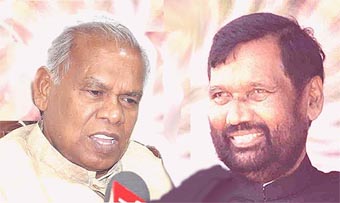 Seldom in the recent decades the established Dalit leaders of Bihar are finding themselves so marginalized in Bihar as now. First the November 8 election verdict made the Lok Janshakti Party leader and Union food minister Ram Vilas Paswan, and former chief minister and the leader of the newly formed Hindustani Awam Morcha politically irrelevant.
Seldom in the recent decades the established Dalit leaders of Bihar are finding themselves so marginalized in Bihar as now. First the November 8 election verdict made the Lok Janshakti Party leader and Union food minister Ram Vilas Paswan, and former chief minister and the leader of the newly formed Hindustani Awam Morcha politically irrelevant.
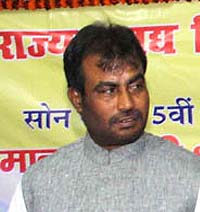 Then came the oath-taking ceremony of the new Nitish Kumar government on November 20. Missing were the top Dalit leaders Ramai Ram, Shyam Rajak and Uday Narayan Chaudhary. The first two had been prominent members of Lalu Prasad, Rabri Devi and Nitish Kumar governments while the last named was the Speaker of the last Bihar Assembly.
Then came the oath-taking ceremony of the new Nitish Kumar government on November 20. Missing were the top Dalit leaders Ramai Ram, Shyam Rajak and Uday Narayan Chaudhary. The first two had been prominent members of Lalu Prasad, Rabri Devi and Nitish Kumar governments while the last named was the Speaker of the last Bihar Assembly.
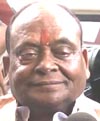 While Ramai Ram and Chaudhary could not find place as they both lost election from their respective Assembly seats Rajak was a surprise omission as he has been left out even though he won from Phulwarisharif seat, the south-western suburb of Patna. He lost the ministerial berth almost after two decades of holding important portfolios. Had he been inducted he would have been the most seasoned Dalit leader in the Nitish cabinet.
While Ramai Ram and Chaudhary could not find place as they both lost election from their respective Assembly seats Rajak was a surprise omission as he has been left out even though he won from Phulwarisharif seat, the south-western suburb of Patna. He lost the ministerial berth almost after two decades of holding important portfolios. Had he been inducted he would have been the most seasoned Dalit leader in the Nitish cabinet.
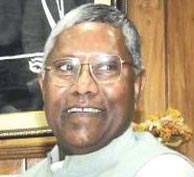 But Ramai Ram, Chaudhary and Rajak come from the three Dalit castes which are not so important in recent Bihar politics as Dussadhs, the caste of Paswan and Musahars, to which Manjhi belongs.
But Ramai Ram, Chaudhary and Rajak come from the three Dalit castes which are not so important in recent Bihar politics as Dussadhs, the caste of Paswan and Musahars, to which Manjhi belongs.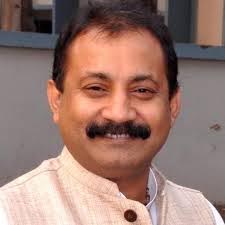 With old Dalit leaders marginalized or sidelined, the four Dalit faces in the new Nitish cabinet are relatively less known names. They are Ashok Chaudhary, who is also the Bihar Pradesh Congress Committee chief. He owes his position more to his father late Mahavir Chaudhary, a senior Congress leader of yesteryears.
With old Dalit leaders marginalized or sidelined, the four Dalit faces in the new Nitish cabinet are relatively less known names. They are Ashok Chaudhary, who is also the Bihar Pradesh Congress Committee chief. He owes his position more to his father late Mahavir Chaudhary, a senior Congress leader of yesteryears.

